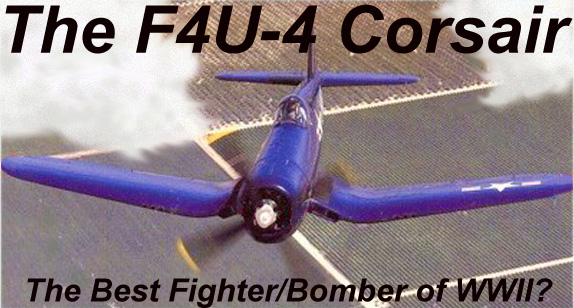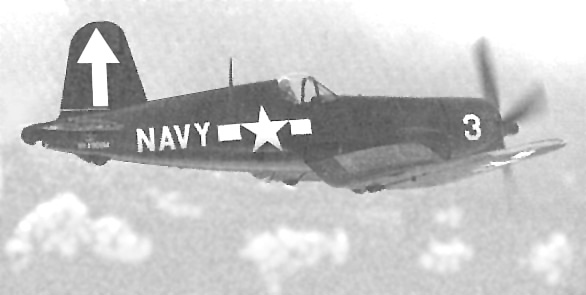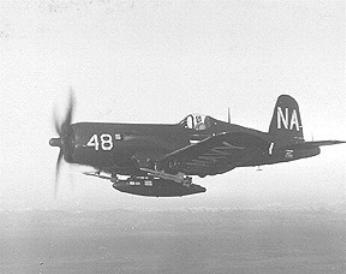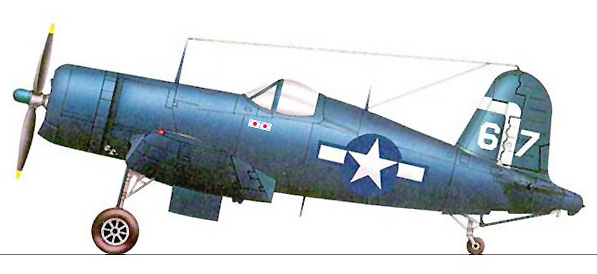
Try Amazon Audible Plus



Since the end of the Second World War, there has raged a continuous debate
over which was the best overall fighter aircraft to emerge from the conflict. This
debate shows no sign of abating to this day. From the school boys of the mid
nineteen forties to the aviation scholars of the 1990’s, P-51 advocates argue
their case with Spitfire men and Lightning defenders, and so goes the debate
forever..........
Or, does it?
While these debates certainly do not lack for passion, they frequently lack accurate analysis of the aircraft in question. There is some solid evidence that strongly supports the argument that the Chance Vought F4U-4 Corsair was the finest all around fighter of the war. Certainly it qualifies as the best fighter/bomber.
The F4U-4 arrived in combat early in 1945. Therefore, it had only about six months to establish its combat record against the Japanese. However, the big fighter remained in service throughout the Korean War, where along with the F4U-5, it gained a sterling reputation for delivering ordnance with great accuracy. Indeed, the Corsair earned the respect of enemy pilots flying the MiG-15. Vought's Corsair was a fighter that could not be treated lightly. In a turning fight below 350 knots, the MiG pilot could find himself in big trouble very quickly.

Chance Vought's F4U-4 came about as a development of the F4U-4XA, which was first flown
in early April 1944. It was fitted with an up-rated Pratt & Whitney R2800-18W or -42W
engine. This powerplant developed 2,450 bhp with water injection. It was also
fitted with a four blade hydromatic propeller which provided the necessary
efficiency to utilize the greater power. The carburetor inlet was moved from
the wing root leading edge to a duct located under the engine. The exhaust
stacks had to be re-routed as a result. Armament remained the same as the F4U-1,
with six .50 caliber Browning MGs. The limited production F4U-4B was armed with four M3 20mm
cannon. Under-wing load capability was substantial. Up to three 1,000 lb.
bombs along with eight 5 inch rockets could be carried. Reportedly, it was not
unusual to rig the F4U-4 with as much as 6,000 lbs of ordnance. Apparently the
robust structure of the Corsair could bear these loads without undue wear and
tear on the airframe. Almost certainly, such overloaded Corsairs did not operate
from carrier decks, but exclusively from shore bases.
Let’s compare the F4U-4 to its earlier sibling, the F4U-1 so that we can clearly see the improvements made.
Maximum speed:
F4U-1: 417 mph @ 19,900 ft.
F4U-4: 446 mph @ 26,200 ft.
The -4 displays a 29 mph speed advantage, but more importantly, does it at a considerably greater altitude. The F4U-4 is actually 10 mph faster than the P-51D at the Mustang’s best altitude.
Rate of climb:
F4U-1: 3,250 ft/min.
F4U-4: 4,170 ft/min.
While the -4 has a more powerful engine, it also weighs more than the F4U-1. This marked increase in climb rate can be attributed to the more efficient 4 blade propeller as well as the higher power of the up-rated powerplant. The increase moves the Corsair into stellar company with fighters such as the P-38L and the F7F Tigercat. The F4U-4 climbs at a rate 20% better than the P-51D.
There is little doubt that the Corsair was likely the greatest load carrying fighter of its era. There is little to compare to it except perhaps late-war models of the P-47, which still fall somewhat short in maximum load.

We now get to the more subjective aspects of the -4’s performance. Rating a
fighter’s flight characteristics is never without pitfalls. What one pilot feels is
too stiff, another might describe as firm or secure. As a result, opinions may
vary. However, empirical data is certainly the most valuable in determining a
fighter’s overall performance. The tangible things such as cockpit layout and
visibility are also important, as are the intangible things such as confidence in
the airframe to get the pilot home. I will do my best to present the subjective
data in an unbiased manner.
In terms of maneuverability, all models of the Corsair were first rate. The F4U-4 was better than the F4U-1 series. Why? More power and better performance in the vertical regime. Very few fighters, even pure fighters such as the Yak-3 could hang with an -4 maneuvering in the vertical. Its terrific climbing ability combined with very light and sensitive controls made for a hard fighter to beat anytime the fight went vertical.
Ease of flight.The Corsair was much less a handful than the P-51 when flown into an accelerated stall, although it was by no means as forgiving as the F6F Hellcat. Torque roll was no worse than most of its high power contemporaries.
The F4U also rolled well. When rolling in conjunction with powerplant torque, in other words, rolling left, it was among the very fastest rolling fighters of the war. In the inventory of American fighters, only the P-47N rolled faster, and only by 6 degrees/second.
In level flight acceleration the F4U-4 gained speed at about 2.4 mph/sec, the P-51D accelerated at about 2.2 mph/sec. The F4U-1 could not keep up with either, accelerating at only 1.5 mph/sec. The real drag racer of American WWII fighters was the P-38L. It gained speed at 2.8 mph/sec. All acceleration data was compiled at 10-15,000 ft at Mil. power settings.
Turning to dive acceleration, we find the F4U-4 and Mustang in a near dead heat. Both the P-47D and P-38L easily out distance the Corsair and P-51D in a dive. Still, these two accelerate better than the opposition from Japan and Germany. Moreover, both the Corsair and the Mustang have relatively high critical Mach numbers allowing them to attain very high speeds in prolonged dives before running into compressibility difficulty. With the exception of early model P-38’s, it was almost always a mistake to attempt to evade American fighters by trying to dive away. This goes for early war fighters as well, such as the P-40 and F4F Wildcat.
There is one story recorded by a Luftwaffe pilot who, while flying a Bf-109F over North Africa tangled with several FAA Martlets (the British name for the F4F). Finding himself alone with a Martlet on his tail, he elected to half roll into a steep dive to shake off the slow flying carrier fighter. Hurtling down in a screaming dive, the German looked over his shoulder and was stunned to see the Martlet (Wildcat) closing with guns blazing. Pulling back on the stick, under heavy G loading, the German eased into a zoom climb. The F4F was still with him firing bursts. As the speed bled down, the Bf-109 began to pull away in a steady rate climb. Had the Brit been a better shot, the German was certain he would have been shot down. He had underestimated the diving ability of the American fighter. Indeed, many of his comrades would do the same over Europe and not be as fortunate as he.
When we look at the turn rates of WWII fighters we stumble upon several factors that determine how well a fighter can turn. Aside from the technical aspects such as wing area and wing loading, we find that some fighters are far more maneuverable at low speeds than at higher velocities. This was very common with Japanese designs. At speeds above 250 mph, the A6M Zero and the Ki-43 Hayabusa (Oscar) could not roll worth a nickel. But at 150 mph, they were two of the most dangerous fighters ever to take wing. It did not take long for Allied pilots to learn to avoid low speed turning duels with the Japanese. Once this rule was established, the light weight dogfighters were hopelessly outclassed by the much faster opposition.
Over Europe, things were somewhat different. The Luftwaffe flew fast, heavily armed aircraft that were not especially suited to low speed turning fights. The Allies had in their inventory the Spitfire, which was very adept at turning fights. The Americans had the P-47, P-38 and P-51. All of which were very fast and at least a match for the German fighters in maneuverability. Especially the P-38 which could out-turn anything the Luftwaffe had and could give the Spitfire pilot pause to consider his own mortality. With the exception of these last two, there was nothing in western Europe that could hang with the F4U-4. Even when including the Soviets, only the Yak-3 could hope to survive a one on one with the Corsair. To do so, the Yak would have to expertly flown. Furthermore, the Yak-3 was strictly a low to medium altitude fighter. Above 20,000 ft its power dropped off rapidly, as did its maneuverability. The Yak-3 in question had better be powered by the Klimov M107A engine and not the low output M105. Otherwise, the speed difference is too great to overcome.

So, perhaps now is a good time to summarize the performance of the F4U-4.
Let’s compare it to the aircraft generally believed to be the best all-around fighter
of World War Two, the North American P-51D Mustang.
Speed: The -4 was about 10 mph faster than the P-51D at the altitude where the
Mustang developed it’s highest speed.
Advantage: F4U-4
Climb: The -4 Corsair was a remarkable climber despite its size and weight. It
could out-climb the Mustang by nearly 800 fpm.
Advantage: F4U-4
Maneuverability: The F4U-4 was one of the very best. According to Jeffrey
Ethell: "Of all World War II fighters, the Corsair was probably the finest in
air-to-air combat for a balance of maneuverability and responsiveness. The -4,
the last wartime version is considered by many pilots who have flown the entire
line to be the best of them all….." Indeed, the F4U-4 had few, if any equals at the
business of ACM (air combat maneuvering).
Advantage: F4U-4
Armament: Equipped with either six .50 caliber machine guns or four 20mm
cannons, the -4 had more than adequate firepower to destroy any aircraft.
It was the premier load carrying single engine fighter of the war. It could get
airborne with bomb loads exceeding that of some twin engine medium bombers.
Advantage: F4U-4
Survivability: There was no other single engine fighter flown during the war that
could absorb greater battle damage than the Corsair and still get home. Even
the USAAF admitted that the F4U was a more rugged airframe than the tank-like
P-47 Thunderbolt. That is a remarkable admission. The big Pratt & Whitney radial
engine would continue to run and make power despite have one or more cylinders
shot off. The P-51D, on the other hand, could be brought down by a single rifle
bullet anywhere in the cooling system.
Advantage: F4U-4
Useful range: The F4U-4 had roughly the same radius of action as the Republic
P-47D-25-RE, which flew escort missions deep into Germany as far as Berlin
(the P-47D-25-RE had 100 gallons of additional internal fuel capacity). Yet,
the P-51D still maintained a big edge in endurance.
Advantage: P-51D
Ease of flight: Despite gaining the nickname of "Ensign Eliminator", the F4U
series tendency to roll under torque was no more difficult to handle than any
other high powered fighter of the era. Some who have flown both the Corsair
and the Mustang state without hesitation that the P-51 exhibited a greater
propensity to roll on its back than did the F4U. Moreover, the Corsair was
a far more forgiving aircraft when entering a stall. Although it would drop its
right wing abruptly, the aircraft gave plenty of advanced warning of an impending
stall by entering a pronounced buffeting about 6-7 mph before the wing dropped.
The P-51, however, gave no warning of an impending stall. When it did stall, it
was with a total loss of pilot control, rolling inverted with a severe aileron snatch.
Recovery usually used up 500 ft or more of altitude. It was not uncommon for
Mustangs to spin out of tight turns during dogfights. The F4U could also be flown at
speeds more than 30 mph slower than that at which the Mustang stalled. In other
words, the P-51 could not hope to follow a Corsair in a low speed turning fight.
Advantage: F4U-4
Outward Visibility: The Corsair provided for very good visibility from the cockpit.
However, few if any WWII fighters offered the pilot a better view than the P-51D.
The earlier P-51B was inferior to the F4U. Nonetheless, it was the D model that
made up the bulk of Mustang production.
Advantage: P-51D
Finally there is an area in which the P-51 cannot compete at all. The F4U was
designed to operate from an aircraft carrier. What this provides for is a utility that
is unmatched by the better land based fighters of WWII. The ability to operate at
sea or from shore can never be over-valued.
Obvious advantage: F4U-4

In conclusion, it would be hard, no, impossible to dismiss the F4U-4 as the
leading candidate for the "best fighter/bomber of WWII". Furthermore, there is
strong evidence that it very well may be the best piston engine fighter (to see
combat) period. Certainly, everyone can agree on this: The F4U-4 Corsair was
at the pinnacle of WWII piston engine technology and performance. When
people debate the relative merits of the great fighter aircraft of WWII, they
would be remiss in not acknowledging the F4U-4 as one of the very best,
and in the educated opinion of many, "the best" fighter aircraft to fly into
combat in World War II.
